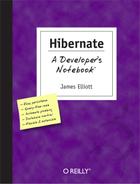4.3. Retrieving Collections
You might expect that getting the collection information back out of the database is similarly easy. You'd be right! Let's enhance our QueryTest class to show us the artists associated with the tracks it displays. Example 4-8 shows the appropriate changes and additions in bold. Little new code is needed.
Example 4-8. QueryTest.java enhanced in order to display artists associated with tracks
1 package com.oreilly.hh;
2
3 import net.sf.hibernate.*;
4 import net.sf.hibernate.cfg.Configuration;
5
6 import java.sql.Time;
7 import java.util.*;
8
9 /**
10 * Retrieve data as objects
11 */
12 public class QueryTest {
13
14 /**
15 * Retrieve any tracks that fit in the specified amount of time.
16 *
17 * @param length the maximum playing time for tracks to be returned.
18 * @param session the Hibernate session that can retrieve data.
19 * @return a list of {@link Track}s meeting the length restriction.
20 * @throws HibernateException if there is a problem.
21 */
22 public static List tracksNoLongerThan(Time length, Session session)
23 throws HibernateException
24 {
25 Query query = session.getNamedQuery(
26 "com.oreilly.hh.tracksNoLongerThan");
27 query.setTime("length", length);
28 return query.list();
29 }
30
31 /**
32 * Build a parenthetical, comma-separated list of artist names.
33 * @param artists the artists whose names are to be displayed.
34 * @return formatted list, or an empty string if the set was empty.
35 */
36 public static String listArtistNames(Set artists) {
37 StringBuffer result = new StringBuffer();
38 for (Iterator iter = artists.iterator(); iter.hasNext(); ) {
39 Artist artist = (Artist)iter.next();
40 result.append((result.length() == 0) ? "(" : ", ");
41 result.append(artist.getName());
42 }
43 if (result.length() > 0) {
44 result.append(") ");
45 }
46 return result.toString();
47 }
48
49 /**
50 * Look up and print some tracks when invoked from the command line.
51 */
52 public static void main(String args[]) throws Exception {
53 // Create a configuration based on the properties file we've put
54 // in the standard place.
55 Configuration config = new Configuration();
56
57 // Tell it about the classes we want mapped, taking advantage of
58 // the way we've named their mapping documents.
59 config.addClass(Track.class).addClass(Artist.class);
60
61 // Get the session factory we can use for persistence
62 SessionFactory sessionFactory = config.buildSessionFactory();
63
64 // Ask for a session using the JDBC information we've configured
65 Session session = sessionFactory.openSession();
66 try {
67 // Print the tracks that will fit in seven minutes
68 List tracks = tracksNoLongerThan(Time.valueOf("00:07:00"),
69 session);
70 for (ListIterator iter = tracks.listIterator() ;
71 iter.hasNext() ; ) {
72 Track aTrack = (Track)iter.next();
73 System.out.println("Track: "" + aTrack.getTitle() + "" " +
74 listArtistNames(aTrack.getArtists()) +
75 aTrack.getPlayTime());
76 }
77 } finally {
78 // No matter what, close the session
79 session.close();
80 }
81
82 // Clean up after ourselves
83 sessionFactory.close();
84 }
85 }
|
How easy was that?
The first thing we add is a little utility method (lines 31–47) to format the set of artist names nicely, as a comma-delimited list inside parentheses, with proper spacing, or as nothing at all if the set of artists is empty.
Next, as with CreateTest, we need to tell Hibernate to map our new Artist class on line 59. Since all the interesting new multi-artist tracks are longer than five minutes, we increase the cutoff in our query to seven minutes so we can see some (line 68). Finally we call listArtistNames() at the proper position in the println() statement describing the tracks found (line 74).
Example 4-9 shows the new output from ant qtest.
Example 4-9. QueryTest output with artist information
% ant qtest
Buildfile: build.xml
prepare:
compile:
[javac] Compiling 1 source file to /Users/jim/Documents/Work/OReilly/
Hibernate/Examples/ch04/classes
qtest:
[java] Track: "Russian Trance" (PPK) 00:03:30
[java] Track: "Video Killed the Radio Star" (The Buggles) 00:03:49
[java] Track: "Gravity's Angel" (Laurie Anderson) 00:06:06
[java] Track: "Adagio for Strings (Ferry Corsten Remix)" (Ferry Corsten,
William Orbit, Samuel Barber) 00:06:35
[java] Track: "Test Tone 1" 00:00:10
BUILD SUCCESSFUL
Total time: 17 seconds
11.940u 1.510s 0:18.06 74.4% 0+0k 0+7io 0pf+0w
|
You'll notice two things. First, that this is much easier to interpret than the columns of numbers in Figure 4-2. And second, it worked! Even in the "tricky" case of the test tone track without any artist mappings, Hibernate takes the friendly approach of creating an empty artists Set, sparing us from peppering our code with the null checks we'd otherwise need to avoid crashing with NullPointerExceptions.
But wait, there's more! No additional code needed…
